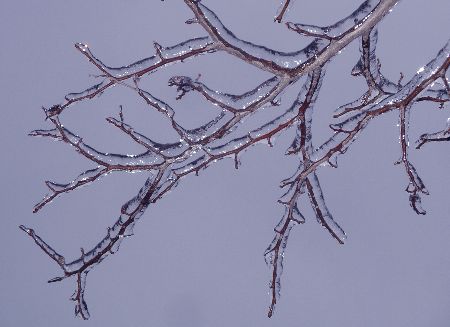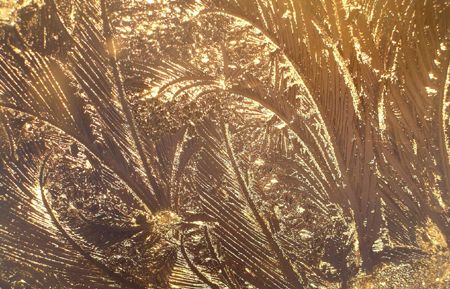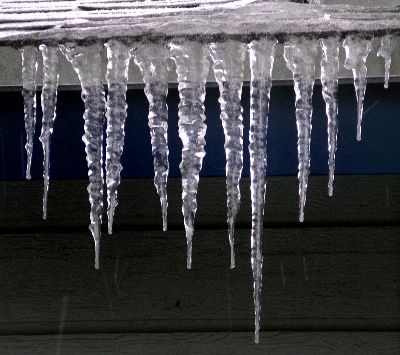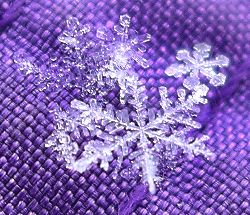


|
Perhaps the most impressive thing about ice is that, as a solid, it is actually lighter in weight than liquid water. Of course, this is because of the way the crystals expand as they solidify, but if it were not for this characteristic, then pond ice would sink instead of floating at the surface where it creates a lid that protects the submerged life below. Looking down into a garden pond covered in an inch of ice and watching a turtle slowly paddle along or seeing small diving beetles squeezing up to the very edge of the ice to get a supply of air gives the impression of a topsy-turvy aquarium, where the viewpoint is from overhead instead of the side. The fact that ice is ABOVE the water also makes it a lot easier to skate upon.
In more northern latitudes, with a long period when the temperature never rises above freezing, there is ice everywhere. From the insidious little clear ice patches on sidewalks that are so treacherous to people merely trying to walk to their front door, to magnificent frozen waterfalls and formations created by wind-whipped waves on the shores of large lakes, natural ice forms abound. People take the time to create ice sculptures in outdoor venues, knowing that their art will endure for weeks, if not months. Here in the South, the frozen form of water is far more fleeting. We might have a couple of days during which the mercury remains below 0°C, but it must also coincide with precipitation to produce any ice worthy of notice.
When we do get an ice storm, it is not necessarily a chance to get out and see some extraordinary winter wonderland, as the roads, congested with vehicles whose drivers have little experience in these conditions, become too dangerous, and we must stay home if we are in our right minds. We can go for walks in our neighborhood, and see the small examples of crystalline beauty within our own yard, but we can forget about driving an hour or two to some state park or natural area with better photo ops.

|
There is one way that we can sometimes see rather impressive ice effects, but it is caused by the most plebian of sources: water sprinklers left on overnight. I once went hiking at the Lady Bird Johnson Wildflower Center in January. It was dry and cold, but a pleasant time to be out. As I strolled through the brown fields, I suddenly caught a glimpse of something very different. My curiosity piqued, I went closer to investigate and found a large area of tall weeds completely coated in over an inch of ice. Blades of grass, dead seed heads, briers and spindly dry branches were all encased in jewel-like elegance. The ice closest to the irrigation spigots took on fantastic sinuous shapes with many wavy edges, caused by being bombarded repeatedly from the side. In the soft morning light, the whole scene looked like a frosted fairyland.
 I've never seen window frost here in our Austin house. It requires that there be enough humidity in the house to make condensation on the windows during the day and that the temperature go low enough at night to freeze this moisture film. Up in Wisconsin, though, the conditions are perfect for producing the lovely filigreed patterns on windows night after night. When we spent a week rooming in the upper floor of my sister's family's farmhouse one February, I checked the frost on the east-facing window every morning at sunrise, just to see what fabulous new shapes it had acquired during the night.
I've never seen window frost here in our Austin house. It requires that there be enough humidity in the house to make condensation on the windows during the day and that the temperature go low enough at night to freeze this moisture film. Up in Wisconsin, though, the conditions are perfect for producing the lovely filigreed patterns on windows night after night. When we spent a week rooming in the upper floor of my sister's family's farmhouse one February, I checked the frost on the east-facing window every morning at sunrise, just to see what fabulous new shapes it had acquired during the night.
Sometimes ice forms directly from water vapor in the atmosphere, a process called sublimation. While this sounds mundane and technical, the end results are some of the most charming in nature: snowflakes and hoarfrost. As a snowflake drifts down through the air, which can take about 15 minutes, it grows just like crystals in a liquid solution do, acquiring the lovely hexagonal symmetry from the water molecules themselves. Hoarfrost is a more terrestrial version of the same kind of development, taking the edge of a leaf, or anything else that is raised above the ground, as the foundation upon which the crystals build. The fleeting nature of both these delicate structures makes them seem all the more magical.
Here in central Texas, one of the most surprising ice forms is that which occurs on Frostweed (Verbesina virginica) at the first freeze of the season. The liquid within the stems expands outward in large, puffy curls of fragile white crystals, probably held together by the consistency and constituents of the sap. While it might look sort of like Styrofoam, it is far more graceful and ephemeral. The resulting formations remind me of such phenomena as gypsum on cave walls and frost heaves that erupt from the soil.
As our first light freezes occur, I always look forward to checking out small puddles and other bits of moisture that are likely to turn solid. This season has already produced some lovely hoarfrost and some interesting ice patterns on the surface of small puddles caused by recent rains. One of the best things about ice is that it has myriad forms that are ever changing, and you never know just what you'll see next.